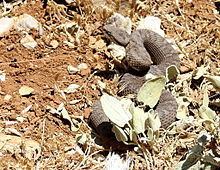Kingdom Animalia Suborder Serpentes Subfamily Viperinae Scientific name Vipera bornmuelleri Higher classification Vipera Order Scaled reptiles | Subphylum Vertebrata Family Viperidae Genus Vipera Phylum Chordata Rank Species | |
 | ||
Similar Snake, Vipers, Vipera, Montivipera, Vipera wagneri | ||
Vipera bornmuelleri is a venomous viper species found in Lebanon, Jordan, Israel and Syria. No subspecies are currently recognized.
Contents
Etymology
The specific name, bornmuelleri, is in honor of German botanist Joseph Friedrich Nicolaus Bornmüller.
Description
V. bornmuelleri grows to a maximum total length (body + tail) of about 75 cm (30 in), but usually much less. Males tend to be larger than females in some populations. In specimens from Mt. Lebanon, the maximum total lengths were 47.3 cm (18.6 in) for females and 53.8 cm (21.2 in) for males. The tail accounts for about 7-10% of the total length.
Geographic range
It is found in high mountain areas in Lebanon and Syria.
Taxonomy
The original syntypes were collected in Lebanon at 1800 m (5,900 ft) and in the Bolkar mountains of western Turkey at 2200 m (7,200 ft) as described by Franz Werner in 1898. In 1922, Werner restricted the type locality to Lebanon in his designation of his specimen as a lectotype, and in 1938 separated out the southern varieties as a separate species (Vipera palaestinae). In 1967 Mertens raised the name bornmuelleri to valid species rank for the Lebanese populations, thus leaving the name xanthina for all Turkish populations, which arrangement was accepted by Baran in 1976, and agreed with by Nilson and Andrén in their 1985 paper.
Conservation status
This species is classified as Endangered (EN) according to the IUCN Red List of Threatened Species with the following criteria: B1ab(iii) (v3.1, 2001). This indicates that it is facing a high risk of extinction in the wild because the extent of its occurrence within its geographic range is estimated to be less than 20,000 km², because its populations are severely fragmented or known to exist at no more than 10 locations, and because a continued decline is observed, inferred or projected in the area, extent and/or quality of its habitat.
Listed as such because its extent of occurrence is less than 5,000 km², its distribution is severely fragmented, and there is a continuing decline in the extent and quality of its mountain habitat due to overgrazing. Year assessed: 2005.
